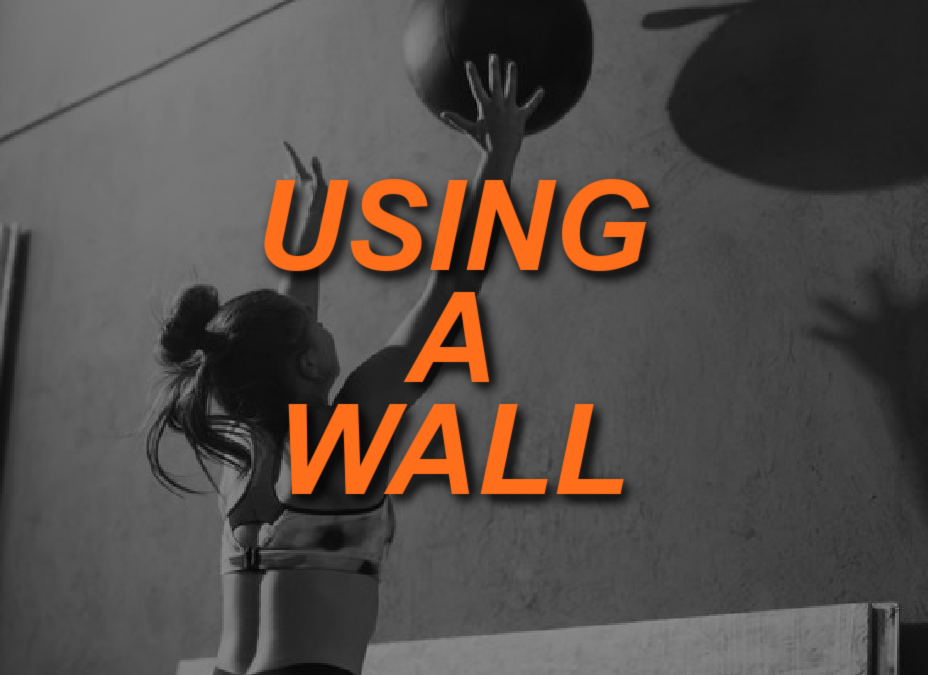Whether you’re training in a client’s home, a gym, or your own home gym, take advantage of the wall. A wall provides the space for stability and is readily available. Using the wall is an excellent way to use what you have.
Beginners benefit from wall support as they build strength and confidence. More advanced clients benefit by trying more challenging exercises with the security of the wall. The wall serves as a stabilizer for balancing and stretching too.
Wall exercises can also be done in hotel rooms or anywhere you go when traveling.
Of course, make sure no objects are in the way. For certain exercises, like wall ball slams and any with shoes on the walls, be sure the wall won’t be damaged. (I write this as I notice a dent in my wall)!
The exercises in the first list of each category don’t require any equipment. The second list includes ideas for supplementing with equipment.
[sc name=”resistance” ][/sc]
Building Overall Strength
Upper Body
• Standing planks
• Floor plank with forearms on the ground and feet braced on the wall; core should be parallel to the ground without an arch or sinking in the middle
• Pushups (wide grip and triceps)
• One arm plank with shoulder taps
• Add hand-held weights to lower body exercises to work the upper body at the same time
• Add a kettlebell to lower body exercises
• Wall ball slams and throws
• Incorporate band upper body exercises while holding a wall-sit or squat
Lower Body
• Squats
• Wall-sits
• Split squats (foot on wall)
• Supported bridge (back on floor and feet on the wall)
• Bender (small Pilates ball) between legs for squats, bridges, and wall-sits
• Bender ball behind lower back for wall-sits and squats
• Stability ball behind the back for wall-sits and squats
Core
• Single leg L stand
• Double leg L stand
• Climbing handstand
• Handstand support
• Shoulder stand support
• Side plank
• Use the wall as a brace for forward jumps using a half-domed ball
• Brace the half-domed ball against the wall for frog leaps
Working on Flexibility and Mobility Using the Wall
Because of the wall’s stability, it’s an ideal spot to work on stretching and flexibility.
Upper body
- For a shoulder opener, face a corner of the room, placing each hand at shoulder height or slightly higher. Step forward enough that there’s a complete stretch across the pecs and shoulders. Lean left, then right for a deeper stretch on each side.
- Another shoulder stretch includes using a small medicine ball or Pilates ball. Hold it in one hand reaching up with a straight arm and leaning toward the wall sideways. Alternate to the other side. Do the same, reaching to each side.
- Wall angels stretch out and properly activate shoulders, chest, and back muscles, with an added bonus of helping to improve posture.
Lower body
Legs up the wall is a popular type of stretch with lots of potential benefits including reducing stress and help with insomnia. The position stretches out hamstrings, glutes, and the lower back muscles.
- Lying supine on the floor, scoot as close to the wall as is comfortable with legs up and resting against the wall.
- Supported figure four stretch stretches out hip flexors and glutes.
- Butterfly stretch for inner thighs and hips.
- Runner’s lateral stretch
Core
- Supported tree pose
- Hold a forward lunge with hands on the wall for a hamstring, shoulder, and back stretch.
- Forward fold
Encourage your clients to shed the wallflower mentality of trying to blend into a wall. Instead, use it as a viable accessory to getting stronger and more flexible.
[sc name=”stretching” ][/sc]
References:
https://www.healthline.com/health/fitness-exercise/wall-exercises#Try-these-moves-for-a-taste-of-a-wall-workout
https://www.prevention.com/fitness/a20447562/wall-workout/
https://www.prevention.com/fitness/g20449323/wall-workout-for-arms-and-abs/
https://www.healthline.com/health/fitness/wall-angels
https://www.premierspineandsports.com/blog/effective-hip-stretches-to-implement-in-your-daily-routine
https://www.tummee.com/yoga-poses/wall-butterfly-pose
Kim Becknell Williams is a freelance writer with more than ten years of personal training experience. Certified through NFPT, she is a Functional Training Specialist and holds a Master Trainer level certificate for resistance, endurance and sports nutrition. Kim has written two books including Gym Etiquette 101. She enjoys writing a variety of lifestyle articles and fitness blogs.


